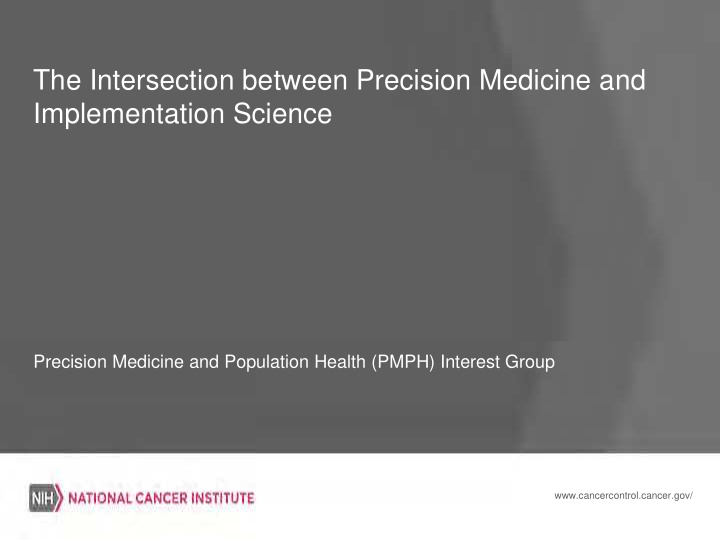



The Intersection between Precision Medicine and Implementation Science Precision Medicine and Population Health (PMPH) Interest Group www.cancercontrol.cancer.gov/
Session Logistics Questions are encouraged. You may submit your questions at any time during the presentation. Type your question in the Q&A feature on the right of the interface and press submit. To connect to the audio, you may have the system call you by entering your telephone number including area code and selecting “Call Me” OR by dialing in to the session at: Conference #: 1-855-244-8681 / 1-650-479-3207 Access Code: 737 251 782 2
Session Logistics Introduction Dr. Muin Khoury (@DrKhouryCDC) Director, Office of Public Health Genomics, CDC Senior Advisor, Division of Cancer Control & Population Sciences, NCI, NIH Presentations Dr. David Chambers (@NCIDAChambers) Deputy Director for Implementation Science, Division of Cancer Control & Population Sciences Dr. Geoffrey Ginsburg (@PersonalizedMed) Professor of Medicine, Pathology, and Biomedical Engineering, Duke University Questions 3
The Intersection between Precision Medicine and Implementation Science David Chambers, DPhil Deputy Director for Implementation Science, Division of Cancer Control & Population Sciences (DCCPS)
Session Outline A Brief Orientation to Implementation Science Considering Implementation Science within Precision Medicine? Challenging Existing Assumptions 5
Balas & Boren, 2000 Original research 18% variable Negative Dickersin, 1987 results Submission 46% 0.5 year It takes 17 years to turn 14 Kumar, 1992 Koren, 1989 Acceptance Negative 0.6 year percent of results Kumar, 1992 Publication Expert original research to the benefit of 35% 0.3 year opinion Poyer, 1982 Balas, 1995 Lack of Bibliographic databases numbers patient care 50% 6. 0 - 13.0 years Antman, 1992 Poynard, 1985 Reviews, guidelines, textbook 9.3 years Inconsistent indexing Implementation “PUBLICATION PATHWAY” 6
We assume… “If you build it…”
Beyond The Test Itself… Even if genetic testing can identify optimal treatment for a specific illness or reduce risk for health problems, if: Only half of insurers choose to provide them Half of those systems choose to train clinicians to prescribe it Half of the clinicians at those systems prescribe it Half of their patients get tested: (Assuming perfect access/testing/follow-up) Impact: .5*.5*.5*.5 = 6% benefit Adapted from Glasgow, RE-AIM
Key Terms Implementation Science is the study of methods to promote the integration of research findings and evidence into healthcare policy and practice. Dissemination research is the scientific study of targeted distribution of information and intervention materials to a specific public health or clinical practice audience. The intent is to understand how best to spread and sustain knowledge and the associated evidence-based interventions. Implementation research is the scientific study of the use of strategies to adopt and integrate evidence-based health interventions into clinical and community settings in order to improve patient outcomes and benefit population health. 9
Dissemination Research focuses on the process through: How the “evidence” is created? Packaging Transmitting Receiving Turning Information into Action
Studying Implementation Implementation Service Health Outcomes Outcomes Outcomes* Feasibility Efficiency Satisfaction What? How? Fidelity Safety Function THE CORE OF Penetration Effectiveness Health status/ QIs Implementation TH E U TAT SU N AL Acceptability Equity symptoms IMPL EMEN IO Strategies Sustainability Patient- ESTs RESEARCH Uptake centeredness Costs Timeliness *IOM Standards of Care Implementation Research Methods Proctor et al 2009 Admin. & Pol. in Mental Health & Mental Health Services Research Proctor et al, 2009, APMH&MHSR
Dissemination and Implementation (D&I) Research-- Theories, empirical findings, and methods from a variety of fields: information science, clinical decision-making, organizational and management theory, economics, individual and systems-level behavioral change, public health, business and public administration, statistics, anthropology, learning theory, engineering, and marketing. Collaboration with stakeholders from multiple practice settings, consumers of services and their families/social networks. Rigorous and relevant methodological approaches (e.g. observational, experimental, quasi-experimental, and simulation modeling) Studies of dissemination or implementation strategies should build knowledge both on the overall effectiveness of the strategies, as well as "how and why" they work (e.g. mechs, moderators, mediators)
Current Funding Announcements NIH: PAR-16-237; 13-238;13-236 (R03, R01, R21) NCI leads (16 ICs total, including FIC, NIMH, NHLBI, NHGRI, as well as OBSSR) Organizes the D&I research agenda across NIH >150 grants funded through NIH since 2006 2010 CSR standing review committee Modal Grant—Randomized trial of an implementation strategy for an effective intervention (where we’ve been)
Example: Lynch Syndrome Sample IS Challenges: • ID of Lynch Syndrome within CRC pop • Family member scale-up • Implementing screening/ monitoring/
Example Two: BRCA1/2 Sample IS Challenges: • ID of BRCA1/2 at pop level • Family member scale-up • Implementing screening/ monitoring/ pre-emptive Tx
Example Three: PMI Sample IS Challenges • How does clinical practice incorporate PMI findings? • How do you implement evidence that will be evolving? • How do you train and support the workforce? • What services will be covered/paid for?
Traditional Assumptions Evidence and Evidence-based practices are static System is static Implementation proceeds one practice or test at a time Consumers/Patients are homogeneous Choosing to not implement is irrational How well do these relate to the implementation of precision medicine?
Choosing not to implement is irrational… (Does it fit? ) • QUESTIONS ABOUT “ACTIONABILITY” • WHAT IS REIMBURSED? • IS COUNSELING AVAILABLE? • ARE EXISTING TESTS OPTIMAL? • IS THERE A DEMAND FOR THE KNOWLEDGE?
S ustainability or Evolution? • IF PRECISION MEDICINE CONTINUES TO EVOLVE, SHOULD EXISTING INTERVENTIONS BE SUSTAINED IN THE SAME FORM THAT WE’VE CREATED THEM? • HOW DOES THE SYSTEM COPE WITH A DYNAMIC FIELD THAT IS CONSTANTLY CHANGING? • WHERE DO WE GO http://www.thestrut.com/2012/12/19/the-evolution-of-the-beatles-hair/ FROM HERE?
A Dynamic Approach to Sustainability… Chambers, Stange, & Glasgow, Implementation Science, 2013
Enter the learning health care system… Stein, Adams, Chambers. Psychiatric Services, 2016.
Hope for the future…
Guiding Principles for IS & PM… First, context matters and is multilevel. Second, it’s not just whether a practice works, but whether that practice can be delivered in many real-world settings. Third, there are effective strategies to implement evidence- based practices. Fourth, implementation science is a team sport. Partnerships needed with a range of stakeholders, including patients, clinicians, administrators, researchers, and policy makers.
dchamber@mail.nih.gov 240-276-5090 @NCIDAChambers 24
www.cancer.gov www.cancer.gov/espanol
Recommend
More recommend